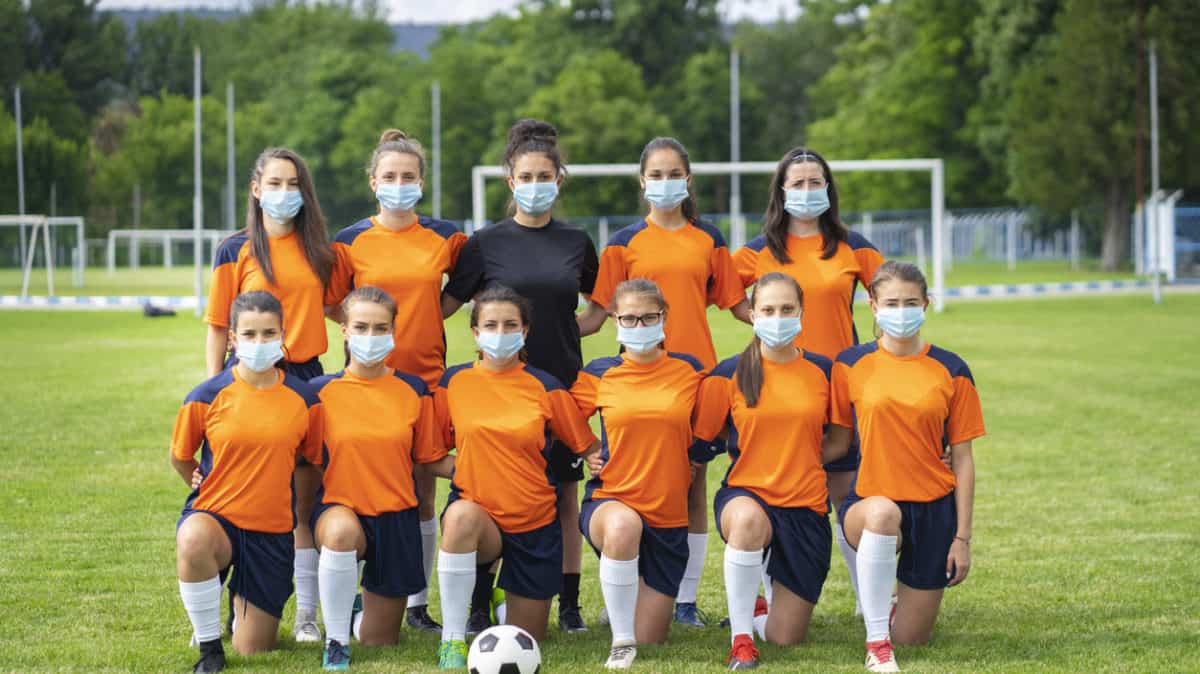3 Training Hacks for Better Football Combine Results
This year, I trained my first athlete for the NFL Combine tests and his pro day. Needless to say, it was a daunting experience. You know very clearly what numbers the athlete is starting at, and from there you must make improvements.
The hardest part?
You often only have 8 to 12 weeks to see some serious results.
My good friends Joe Kenn (Carolina Panthers) and Nick Winkelman (EXOS) gave me great feedback here:
Imagine one of the best athletes you’ve ever worked with. He’s two days off a bowl game and a full college season. Now imagine you have eight weeks to take this guy who is beat up and injured, and make him bigger, faster and stronger than he’s ever been before.
This stuff isn’t easy, and it’s going to put your programming and coaching skills to the test.
RELATED: 5 Secrets From an NFL Combine Coach
My Athlete
My situation was a bit different from most. The athlete I was training was coming off an injury, and I actually had extra time to work with him.
The first two months were primarily base building; I didn’t want to overstress the injured area. What we did over the course of our time together was pretty astounding, though.
Here are some of the before and after numbers:
|
Pre-IFAST |
Pro Day(s) |
|
| 40-Yard Dash |
4.81 seconds |
4.56 seconds |
| Vertical Jump |
32 inches |
36.5 inches |
| Broad Jump |
8 feet 11 inches |
9 feet 11.5 inches |
| 3-Cone Drill |
7.16 seconds |
6.9 seconds |
| Pro Agility |
4.38 seconds |
3.97 seconds |
Up to this point, I’ve only coached one athlete, but I’ve done my homework and I think there are a few hidden hacks you can use to give yourself a leg up on the competition.
WATCH: Jadeveon Clowney’s NFL Combine Training
Hack 1: Technique, Technique, Technique and Practice, Practice, Practice
Flash back to 10th grade. Your teacher says you’re going to have a test, and she’s feeling nice, so she tells you the exact questions that will be on it. If this were the case, you’d make darn sure you studied those exact questions, right?
Training for a pro day is no different.
You don’t let your athlete show up on test day and assume he’s going to do well. I don’t care how good the “natural athlete” is you are working with. This is a specific set of tests, and he needs to practice them to be at his best.
If it’s a 3-Cone Drill, you want him to get to that first cone in 2.5 steps, and get back in two steps.
If it’s the 40-Yard Dash, you’re drilling starts with the first 10 yards and finishes with fast and loose arm action.
And if it’s the 225-pound Bench Test, you work on staying tight and keeping a nice, efficient line throughout the test.
Bottom line: If you’re not consistently working on portions of the test (or the entire test), you’re leaving performance on the table. If you focus on technique throughout the course of your athlete’s preparation, you will boost his performance.
Hack 2: Core Strength and Stability
You won’t hear about this in most football combine prep articles, but core strength and stability are critical to performance.
Want to improve stride length in the 40? Get your athlete’s core stronger so his hip flexors and hamstrings can relax.
Want to get tighter cuts on the 3-Cone or Pro Agility Drills? An unstable core leads to postural sway, so tightening up here can mean precious hundredths of a second.
Strengthening and stabilizing your athlete’s core will also help his Bench Press, which is a total-body lift involving the upper body, legs and core.
Unfortunately, although many athletes’ cores look great, their performance and function are often poor. I usually start them off in basic postures and positions to get them moving in the right direction. My go-to core training exercises are:
These exercises may look easy, but when done properly, they are far more challenging than you might expect. A few quick cues to make sure you’re getting the most out of these exercises:
- Exhale fully to get the rib cage down.
- “Roll” the pelvis back using the lower abs.
- Keep the back of the head and neck long.
- Do not let the back arch or extend off the floor when going through the range of motion.
I’ve used these exercises with everyone from middle school athletes up to the professionals, and the results are nothing less than spectacular.
WATCH: Mike Boyle Discusses the Importance of Anti-Extension Core Exercises
Hack 3: Focus on Efficiency
If you only have eight weeks to get an athlete ready to perform at a high level, your back is against the wall.
Can you get them a bit stronger? Probably.
Or a bit more powerful? Maybe.
But you know what you can absolutely, positively do in eight weeks? Make them more efficient.
Focus on the big lifts like Squats, Bench Press, Deadlifts, Olympic lifts or whatever your favorites are. These will give your athlete a bigger motor, which should absolutely transfer to improved performance. But don’t forget how low-level exercises can improve efficiency or economy of movement.
We already mentioned how smart core training can improve force transfer and enhance the ability to change direction effectively. But what other options do we have?
I‘ve never met an athlete whose backside was strong enough. Therefore, posterior chain exercises such as RDLs and Glute-Ham Raises are mainstays in my programming. Posterior chain strength and power provide direct carryover to the Broad Jump and 40-Yard Dash, so that’s a no-brainer.
I’m also a huge fan of half-kneeling exercises, Split-Squats and Lunges. The obvious benefit is promoting single-leg strength, but I think it goes deeper than that. I use these exercises for two reasons:
- To inhibit the hip flexors, which allows better position and firing potential for the posterior chain
- For single-leg stability and control
If you can shut off a hip flexor, you will immediately add more potential to improve your athlete’s 40-Yard Dash, Vertical Jump and Broad Jump.
And if you can improve single-leg stability and control, it will carry over to not only the 40, but the Pro Agility and 3-Cone Drill.
RELATED: 7 Reasons Your Workouts Don’t Work
RECOMMENDED FOR YOU
3 Training Hacks for Better Football Combine Results
This year, I trained my first athlete for the NFL Combine tests and his pro day. Needless to say, it was a daunting experience. You know very clearly what numbers the athlete is starting at, and from there you must make improvements.
The hardest part?
You often only have 8 to 12 weeks to see some serious results.
My good friends Joe Kenn (Carolina Panthers) and Nick Winkelman (EXOS) gave me great feedback here:
Imagine one of the best athletes you’ve ever worked with. He’s two days off a bowl game and a full college season. Now imagine you have eight weeks to take this guy who is beat up and injured, and make him bigger, faster and stronger than he’s ever been before.
This stuff isn’t easy, and it’s going to put your programming and coaching skills to the test.
RELATED: 5 Secrets From an NFL Combine Coach
My Athlete
My situation was a bit different from most. The athlete I was training was coming off an injury, and I actually had extra time to work with him.
The first two months were primarily base building; I didn’t want to overstress the injured area. What we did over the course of our time together was pretty astounding, though.
Here are some of the before and after numbers:
|
Pre-IFAST |
Pro Day(s) |
|
| 40-Yard Dash |
4.81 seconds |
4.56 seconds |
| Vertical Jump |
32 inches |
36.5 inches |
| Broad Jump |
8 feet 11 inches |
9 feet 11.5 inches |
| 3-Cone Drill |
7.16 seconds |
6.9 seconds |
| Pro Agility |
4.38 seconds |
3.97 seconds |
Up to this point, I’ve only coached one athlete, but I’ve done my homework and I think there are a few hidden hacks you can use to give yourself a leg up on the competition.
WATCH: Jadeveon Clowney’s NFL Combine Training
Hack 1: Technique, Technique, Technique and Practice, Practice, Practice
Flash back to 10th grade. Your teacher says you’re going to have a test, and she’s feeling nice, so she tells you the exact questions that will be on it. If this were the case, you’d make darn sure you studied those exact questions, right?
Training for a pro day is no different.
You don’t let your athlete show up on test day and assume he’s going to do well. I don’t care how good the “natural athlete” is you are working with. This is a specific set of tests, and he needs to practice them to be at his best.
If it’s a 3-Cone Drill, you want him to get to that first cone in 2.5 steps, and get back in two steps.
If it’s the 40-Yard Dash, you’re drilling starts with the first 10 yards and finishes with fast and loose arm action.
And if it’s the 225-pound Bench Test, you work on staying tight and keeping a nice, efficient line throughout the test.
Bottom line: If you’re not consistently working on portions of the test (or the entire test), you’re leaving performance on the table. If you focus on technique throughout the course of your athlete’s preparation, you will boost his performance.
Hack 2: Core Strength and Stability
You won’t hear about this in most football combine prep articles, but core strength and stability are critical to performance.
Want to improve stride length in the 40? Get your athlete’s core stronger so his hip flexors and hamstrings can relax.
Want to get tighter cuts on the 3-Cone or Pro Agility Drills? An unstable core leads to postural sway, so tightening up here can mean precious hundredths of a second.
Strengthening and stabilizing your athlete’s core will also help his Bench Press, which is a total-body lift involving the upper body, legs and core.
Unfortunately, although many athletes’ cores look great, their performance and function are often poor. I usually start them off in basic postures and positions to get them moving in the right direction. My go-to core training exercises are:
These exercises may look easy, but when done properly, they are far more challenging than you might expect. A few quick cues to make sure you’re getting the most out of these exercises:
- Exhale fully to get the rib cage down.
- “Roll” the pelvis back using the lower abs.
- Keep the back of the head and neck long.
- Do not let the back arch or extend off the floor when going through the range of motion.
I’ve used these exercises with everyone from middle school athletes up to the professionals, and the results are nothing less than spectacular.
WATCH: Mike Boyle Discusses the Importance of Anti-Extension Core Exercises
Hack 3: Focus on Efficiency
If you only have eight weeks to get an athlete ready to perform at a high level, your back is against the wall.
Can you get them a bit stronger? Probably.
Or a bit more powerful? Maybe.
But you know what you can absolutely, positively do in eight weeks? Make them more efficient.
Focus on the big lifts like Squats, Bench Press, Deadlifts, Olympic lifts or whatever your favorites are. These will give your athlete a bigger motor, which should absolutely transfer to improved performance. But don’t forget how low-level exercises can improve efficiency or economy of movement.
We already mentioned how smart core training can improve force transfer and enhance the ability to change direction effectively. But what other options do we have?
I‘ve never met an athlete whose backside was strong enough. Therefore, posterior chain exercises such as RDLs and Glute-Ham Raises are mainstays in my programming. Posterior chain strength and power provide direct carryover to the Broad Jump and 40-Yard Dash, so that’s a no-brainer.
I’m also a huge fan of half-kneeling exercises, Split-Squats and Lunges. The obvious benefit is promoting single-leg strength, but I think it goes deeper than that. I use these exercises for two reasons:
- To inhibit the hip flexors, which allows better position and firing potential for the posterior chain
- For single-leg stability and control
If you can shut off a hip flexor, you will immediately add more potential to improve your athlete’s 40-Yard Dash, Vertical Jump and Broad Jump.
And if you can improve single-leg stability and control, it will carry over to not only the 40, but the Pro Agility and 3-Cone Drill.
RELATED: 7 Reasons Your Workouts Don’t Work











